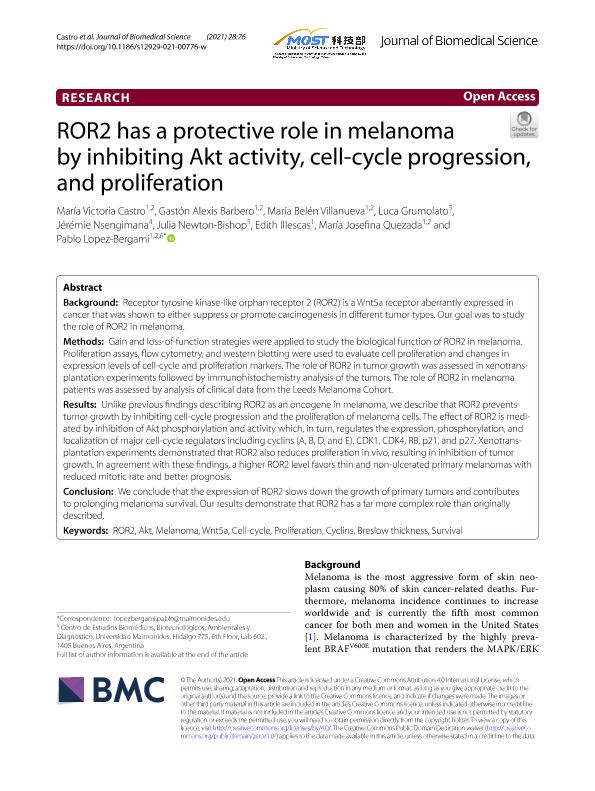Mostrar el registro sencillo del ítem
dc.contributor.author
Castro, María Victoria

dc.contributor.author
Barbero, Gastón Alexis

dc.contributor.author
Villanueva, María Belén

dc.contributor.author
Grumolato, Luca
dc.contributor.author
Nsengimana, Jérémie
dc.contributor.author
Newton-Bishop, Julia
dc.contributor.author
Illescas, Edith
dc.contributor.author
Quezada, Maria Josefina

dc.contributor.author
Lopez Bergami, Pablo Roberto

dc.date.available
2022-08-24T19:37:24Z
dc.date.issued
2021-12
dc.identifier.citation
Castro, María Victoria; Barbero, Gastón Alexis; Villanueva, María Belén; Grumolato, Luca; Nsengimana, Jérémie; et al.; ROR2 has a protective role in melanoma by inhibiting Akt activity, cell-cycle progression, and proliferation; BioMed Central; Journal Of Biomedical Science; 28; 1; 12-2021; 1-15
dc.identifier.uri
http://hdl.handle.net/11336/166496
dc.description.abstract
Background: Receptor tyrosine kinase-like orphan receptor 2 (ROR2) is a Wnt5a receptor aberrantly expressed in cancer that was shown to either suppress or promote carcinogenesis in different tumor types. Our goal was to study the role of ROR2 in melanoma. Methods: Gain and loss-of-function strategies were applied to study the biological function of ROR2 in melanoma. Proliferation assays, flow cytometry, and western blotting were used to evaluate cell proliferation and changes in expression levels of cell-cycle and proliferation markers. The role of ROR2 in tumor growth was assessed in xenotransplantation experiments followed by immunohistochemistry analysis of the tumors. The role of ROR2 in melanoma patients was assessed by analysis of clinical data from the Leeds Melanoma Cohort. Results: Unlike previous findings describing ROR2 as an oncogene in melanoma, we describe that ROR2 prevents tumor growth by inhibiting cell-cycle progression and the proliferation of melanoma cells. The effect of ROR2 is mediated by inhibition of Akt phosphorylation and activity which, in turn, regulates the expression, phosphorylation, and localization of major cell-cycle regulators including cyclins (A, B, D, and E), CDK1, CDK4, RB, p21, and p27. Xenotransplantation experiments demonstrated that ROR2 also reduces proliferation in vivo, resulting in inhibition of tumor growth. In agreement with these findings, a higher ROR2 level favors thin and non-ulcerated primary melanomas with reduced mitotic rate and better prognosis. Conclusion: We conclude that the expression of ROR2 slows down the growth of primary tumors and contributes to prolonging melanoma survival. Our results demonstrate that ROR2 has a far more complex role than originally described.
dc.format
application/pdf
dc.language.iso
eng
dc.publisher
BioMed Central

dc.rights
info:eu-repo/semantics/openAccess
dc.rights.uri
https://creativecommons.org/licenses/by/2.5/ar/
dc.subject
AKT
dc.subject
BRESLOW THICKNESS
dc.subject
CELL-CYCLE
dc.subject
CYCLINS
dc.subject
MELANOMA
dc.subject
PROLIFERATION
dc.subject
ROR2
dc.subject
SURVIVAL
dc.subject
WNT5A
dc.subject.classification
Bioquímica y Biología Molecular

dc.subject.classification
Ciencias Biológicas

dc.subject.classification
CIENCIAS NATURALES Y EXACTAS

dc.title
ROR2 has a protective role in melanoma by inhibiting Akt activity, cell-cycle progression, and proliferation
dc.type
info:eu-repo/semantics/article
dc.type
info:ar-repo/semantics/artículo
dc.type
info:eu-repo/semantics/publishedVersion
dc.date.updated
2022-08-23T11:21:58Z
dc.identifier.eissn
1423-0127
dc.journal.volume
28
dc.journal.number
1
dc.journal.pagination
1-15
dc.journal.pais
Reino Unido

dc.journal.ciudad
Londres
dc.description.fil
Fil: Castro, María Victoria. Consejo Nacional de Investigaciones Científicas y Técnicas; Argentina. Universidad Maimónides. Área de Investigaciones Biomédicas y Biotecnológicas. Centro de Estudios Biomédicos, Biotecnológicos, Ambientales y de Diagnóstico; Argentina
dc.description.fil
Fil: Barbero, Gastón Alexis. Consejo Nacional de Investigaciones Científicas y Técnicas; Argentina. Universidad Maimónides. Área de Investigaciones Biomédicas y Biotecnológicas. Centro de Estudios Biomédicos, Biotecnológicos, Ambientales y de Diagnóstico; Argentina
dc.description.fil
Fil: Villanueva, María Belén. Consejo Nacional de Investigaciones Científicas y Técnicas; Argentina. Universidad Maimónides. Área de Investigaciones Biomédicas y Biotecnológicas. Centro de Estudios Biomédicos, Biotecnológicos, Ambientales y de Diagnóstico; Argentina
dc.description.fil
Fil: Grumolato, Luca. University of Rouen; Francia
dc.description.fil
Fil: Nsengimana, Jérémie. University of Newcastle; Reino Unido
dc.description.fil
Fil: Newton-Bishop, Julia. Leeds Institute Of Medical Research; Reino Unido
dc.description.fil
Fil: Illescas, Edith. Universidad Maimónides. Área de Investigaciones Biomédicas y Biotecnológicas. Centro de Estudios Biomédicos, Biotecnológicos, Ambientales y de Diagnóstico; Argentina
dc.description.fil
Fil: Quezada, Maria Josefina. Consejo Nacional de Investigaciones Científicas y Técnicas; Argentina. Universidad Maimónides. Área de Investigaciones Biomédicas y Biotecnológicas. Centro de Estudios Biomédicos, Biotecnológicos, Ambientales y de Diagnóstico; Argentina
dc.description.fil
Fil: Lopez Bergami, Pablo Roberto. Consejo Nacional de Investigaciones Científicas y Técnicas; Argentina. Universidad Maimónides. Área de Investigaciones Biomédicas y Biotecnológicas. Centro de Estudios Biomédicos, Biotecnológicos, Ambientales y de Diagnóstico; Argentina
dc.journal.title
Journal Of Biomedical Science

dc.relation.alternativeid
info:eu-repo/semantics/altIdentifier/url/https://jbiomedsci.biomedcentral.com/articles/10.1186/s12929-021-00776-w
dc.relation.alternativeid
info:eu-repo/semantics/altIdentifier/doi/https://doi.org/10.1186/s12929-021-00776-w
Archivos asociados
